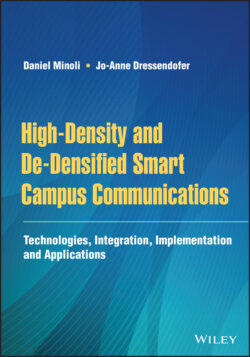Читать книгу High-Density and De-Densified Smart Campus Communications - Daniel Minoli - Страница 40
2.5.2 Beamforming
ОглавлениеBeamforming is a methodology that focuses the AP's transmit energy of the spatial stream toward the targeted WN. Channel estimation is employed to introduce a small difference in the phase and amplitude in the transmitted signal (a process called precoding) to enable the AP to focus the signal in the direction of the receiving WN. 802.11n had previously defined a number of methods of beamforming, and consequently, chipset vendors implemented various non‐interoperable techniques, keeping beamforming from general acceptance. To address the issue, the 802.11ac specification defined a single closed‐loop SU/MU Transmit Beamforming (TxBF) method where the AP transmits a “special sounding signal” to all WNs – each WN estimates the channel and reports its channel feedback information back to the AP. In the sounding mechanisms, each WN provides channel feedback, which the AP uses to give its spatial streams the necessary mobility. Once channel probing request to the WN results in the WN providing the AP with a characterization of its environment, the AP uses MU‐MIMO beam‐shaping capabilities to maximize signal in the desired direction and squelch the signal in the undesired direction. MU‐MIMO capitalizes on the transmit beamforming capabilities to establish up to four simultaneous directional RF links: this technique provides each of the four users with its own dedicated full‐bandwidth channel. In practice, however, the beamforming process is imperfect, and some of the energy of a spatial stream appears in sidelobes for several degrees off‐axis. Two adjacent MU‐MIMO streams start to interfere with each other as soon as their sidelobes begin to overlap. The presence of this interference adds to the overall noise floor of the channel at the AP. Analysis shows that adding additional MU spatial stream adds intra‐stream interference but increases the number of usable spatial streams; this requires a design tradeoff analysis for specific environments and applications [21].
